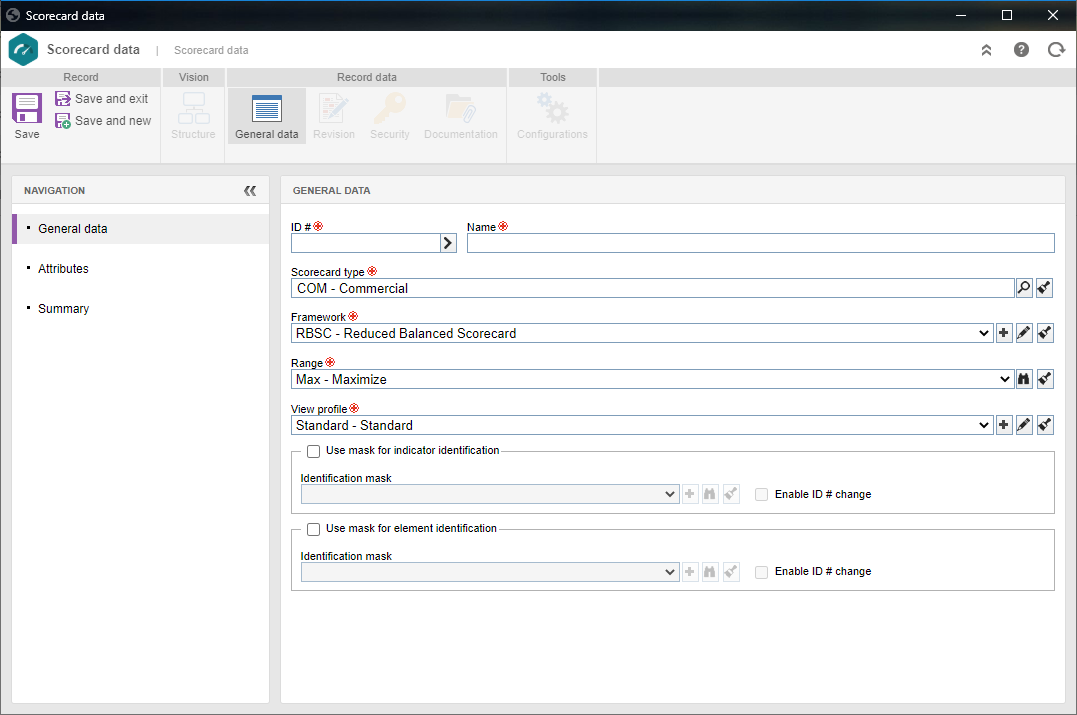See a quick and easy way of creating a scorecard in the "Create a scorecard" topic of the SE Performance Quick Guide!
|
To add a new scorecard, click on the arrow next to the  button on the main screen toolbar and select one of the following options: button on the main screen toolbar and select one of the following options:
▪Add: Allows creating a blank scorecard. On the screen that will be displayed, select the type that will classify the scorecard and save the selection. To successfully add a scorecard, the logged-in user must have the Add control allowed in the security list of the selected type. ▪New from a template: Allows creating a scorecard based on a template created previously. On the screen that will be displayed, locate and select the desired scorecard template and save the selection. ▪New from existing: Allows creating a scorecard based on another previously created scorecard. On the screen that will be displayed, locate and select the desired scorecard and save the selection.
On the scorecard data screen that will be displayed, fill out the fields of the following subsections in the General data section:

Field
|
|
ID #
|
Enter a number or code to identify the scorecard or use the arrow next to this field to generate an automatic ID #. If the use of an identification mask was configured in the type, at the moment of generating the automatic ID #, the respective mask will be shown.
The ID # generated through the mask can only be edited if the "Enable ID # change" option is checked on the data screen of the scorecard type. Otherwise, it will not be possible to edit the ID # generated.
|
Name
|
Enter a name for the scorecard.
|
Scorecard type
|
Displays the type that classifies the scorecard, and it is possible to edit it. In that case, select the type that should classify the scorecard template.
|
Framework
|
Displays the framework most used by the system, but it is possible to edit it. In this case, select the framework that you wish to apply to the structure of the scorecard. Use the other buttons next to the field to add a new framework and associate it with the scorecard and clear the field.
|
Range
|
Displays the range most used by the system, but it is possible to edit it. In this case, select the range that will classify the result of achieving the target of the indicators of the scorecard.
|
View profile
|
Displays the default view profile; however, it is possible to edit it. In this case, select the view profile that you wish to apply to certain screens of the scorecard. Use the other buttons next to the field to add a new view profile, associate it with the template and clear the field.
|
Option
|
Checked
|
Unchecked
|
Use mask for indicator identification1
|
When adding indicators directly to the structure of scorecard, the automatic identification resource will be used. The following fields will be enabled:
▪Identification mask: Select the desired identification mask. Use the other buttons next to the field to add a new mask, use it to generate the ID # and clear the field. ▪Enable ID # change: Check this option to allow the generated ID # to be manually edited when adding indicators to this scorecard. If it is not checked, the generated ID # may not be edited. |
The ID #s must be manually entered by the user who is adding indicators to the structure of the scorecard.
|
Use mask for element identification1
|
When adding elements directly to the structure of scorecard, the automatic identification resource will be used. The following fields will be enabled:
▪Identification mask: Select the desired identification mask. Use the other buttons next to the field to add a new mask, use it to generate the ID # and clear the field. ▪Enable ID # change: Check this option to allow the generated ID # to be manually edited when adding elements to this scorecard. If it is not checked, the generated ID # may not be edited. |
The ID #s must be manually entered by the user who is adding elements to the structure of the scorecard.
|
If, at the time of the addition of the indicator/element to the scorecard, its type has identification mask configuration, it will be overwritten by the configuration made in these options.
|
This tab will only be displayed if at least one attribute is associated in the Details  Attribute tab on the scorecard type data screen. In that case, enter the value of the displayed attributes. Attributes that are required must necessarily have their values filled in. The way to enter the value of an attribute varies according to the configurations set when creating it. Attribute tab on the scorecard type data screen. In that case, enter the value of the displayed attributes. Attributes that are required must necessarily have their values filled in. The way to enter the value of an attribute varies according to the configurations set when creating it.
|
Use the respective options to enter: descriptions, explanations, weaknesses, strengths, unexpected impacts, lessons learned, results, and recommendations related to the scorecard based on this template.
|
Save the record. At this point, the other sections will be enabled to be filled out. Refer to the Editing a scorecard section for a detailed description about the fields that will be displayed.
|







